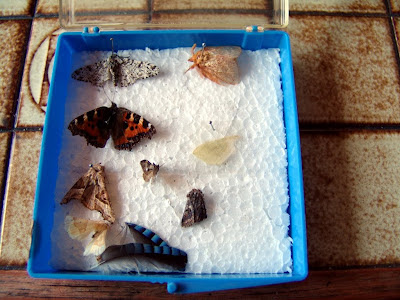Now I can't remember when I first started the collection, although I do know the lid decoration came quite a bit later when I used the collection to gain my Collectors badge in the Cub Scouts.
Now the lid should help explain the title of this post; I only ever collected specimens which I found dead. I would never have (and still wouldn't) consider killing a moth or a butterfly to add it to a collection. Not that I've add to the collection in a number of years, mostly as the boxes have been in my parents loft as Bryony won't let me have them in the house (she likes butterflies but hates moths, even if they are dead), but also as it's a long time since I've actually seen a dead moth or butterfly.
Now I know there are plenty more people, like Bryony, that don't like moths and/or butterflies so for the first time on this blog I'm going to make you click through to the rest of this post so you only see the photos if you want to (although if you are reading this on the post page then the link will be missing and that whole sentence won't make much sense, but nevermind).
I actually have two boxes (the second has a clear lid) so let's open them both up and have a look inside
Unfortunately it would seem that time has not been kind to some of the specimens, although given that they were all collected when they were already dead, some where never in the best of condition. I won't go through each one, but I will highlight some that I find interesting either because there is a story attached or because they are just nice to look at.

Elephant Hawk Moth Deilephila elpenor
I believe this was the first moth I ever collected, which probably explains why it's in the upper-left corner of the box. When alive, and less battered around the edges, the Elephant Hawk Moth is truly a sight to see. With it's large size and bright pink strips it really stands out from it's surroundings. Even the caterpillar is interesting looking (unlike many moths), as it is quite large and appears to have eyes!
Magpie Moth Abraxas grossulariata
Growing up the Magpie moth was probably the moth I saw most as the caterpillars would feed on the gooseberry bushes just outside the back door. Once they had fattened themselves up they would then pupate on the wall under the kitchen window. This particular specemin died while trying to force it's way from the pupa, which you can see to the right. The pupa is actually black with bright yellow stripes when in use as the body of the moth shows through the translucent bands.
Grey Dagger Acronicta psi
Unlike many of the specimens in my collection I can actually remember collecting this one. My brother had a bed with draws underneath (being the younger brother he'd ended up with the small bedroom and needed the extra storage space) which meant there was a 1/2 inch gap between the floor and the bottom of the bed. I can't quite remember what we had lost under the bed, probably a marble or something, but we used a ruler to fish around under the bed to pull a lost toy out. On the first attempt we didn't find what we were looking for but we did find a dead Grey Dagger moth. At least I've always assumed it was a Grey Dagger, but according to my moth book they are almost indistinguishable from a Dark Dagger.
Angle Shades Phlogophora meticulosa
Now I don't have an interesting story to go with this moth, and I have no recollection of how it ended up in my collection. I'm including it here for two reasons. Firstly it was in the second box, and hence is newer and has survived in a better condition than some of the other specimens. My main reason for including it though is it's name; it always makes me thing of an angle poise desk lamp crossed with a large frilly light shade (yes I know I'm strange).
Peppered Moth Biston betularia
Peppered moths are very interesting in that they appear in a number of different coloured forms. The specimen in my collection is the normal form, but you can find moths which are completely black and anywhere in between. I actually found this one next to a live black one. The theory behind the possible range of colours is to do with them being able to blend in when resting on walls. When buildings were regularly being turned black from soot and smoke the suggestion was that being black would have been a useful advantage. You can read lots about this fascinating moth in the book Of Moths and Men by Judith Hooper.So there you go, you've now seen my moth and butterfly collection. Hopefully I haven't creeped you out.... too much!







 Friday, 13 April 2012
Friday, 13 April 2012






Interesting, Mark. I love moths and butterflies so you definitely haven't freaked me out. Apart from the occasional dead Monarch Butterfly and lots of fairly uninteresting and brown moths (I've only bothered identifying the occasional specimen) attracted to the lights of The Cottage I can't say that I've really come across many dead moths and butterflies. In any case I have never been a collector of anything except books and CDs.
Great post Mark. What are the two in the first box that look like dragonfly exuviae - second from the left on the bottom row and the one above?
Helen, the easy answer is that I can't remember. I'll post a better photo of them soon and hopefully you can tell me!
Post a Comment